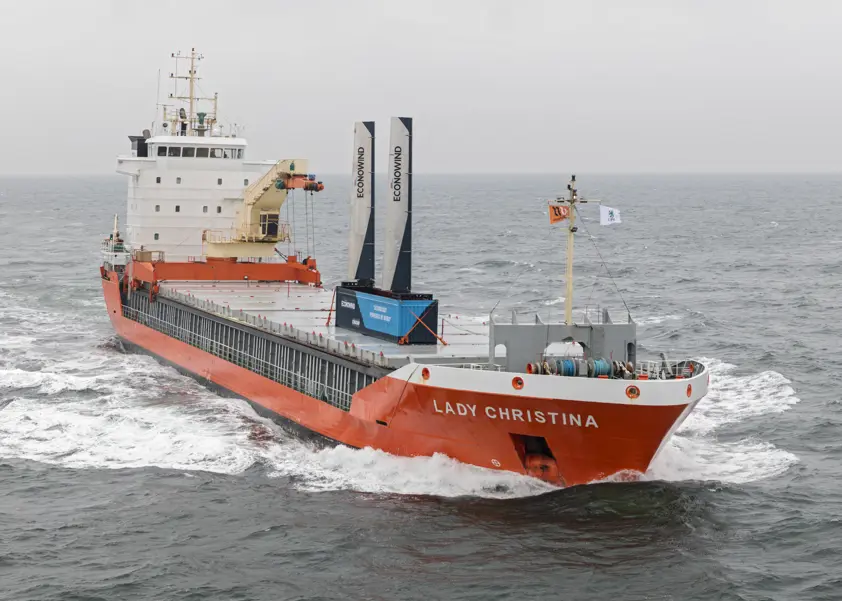Once the MV Lady Christina entered the North Sea, two wing-shaped aluminium foils rose out of the container lashed to its deck and the vessel immediately lurched forward. With winds of over 15 m/s coming across its bows, these ‘ventifoils’ – more like aeroplane wings than sails – were soon taking a significant strain off the engine, allowing the ship’s Captain Derk Ganzeveld to reduce the engine load.
The new wind propulsion unit from eConowind began its maiden voyage on the ship, chartered by UPM on 19 November 2018, travelling from Emden in Germany to Plymouth in the UK, and then on to Rauma in Finland.
“We were quite positively surprised about the amount of savings we could make when the wind was favourable,” says Lauri Rikala, UPM’s Director of Global Break Bulk Shipping. “I think the owners were calibrating fuel savings of about 10% a day, which is close to one tonne.”
With just one unit, eConowind estimates the ship would reduce fuel use by 7%–11%.
Enthusiastic welcome
Lady Christina’s manager, the shipping company Wijnne Barends has a long partnership with eConowind’s co-owners, the marine architects Conoship International.
“When we first heard about the system, we were immediately excited,” says Hein Bijlholt, from the company’s technical department, pointing to the potential to save fuel and reduce emissions. “It wasn’t difficult to make the crew and other people involved enthusiastic. Everyone likes it.”
When UPM was approached, the company immediately gave the green light for a trial. “It's part of UPM's strategy to decrease the environmental footprint of UPM products and logistics,” says Rikala.
Since the International Maritime Organisation (IMO) committed in April to halve the industry’s carbon emissions at least by 2050, ship owners are starting to come under more pressure to reduce their climate impact.
Now eConowind is one solution seeking reductions in engine load. Frank Nieuwenhuis, co-owner of eConowind, likens the ventifoil to an aeroplane’s wing. It is mounted vertically and fitted with an ovoidal tube which pulls in air, increasing the depression on one side of the sail.
“We make a very thick wing, and by sucking away a little bit of air in the right place, we can make the area of low pressure really extreme,” he explains. “Relative to the size of the wing, it gives it quite high power.”
The wing concept for ship propulsion was originally patented as a ‘turbosail’ by the marine visionary Jacques-Yves Cousteau, who used them to power his expedition ship Alcyone. Conoship brought in Nieuwenhuis, a mechanical engineer, to develop the concept after discovering that Cousteau’s patent had expired.
Easy to reef, retract and remove
After Lady Christina left Plymouth, loaded with china clay, it was met with a strong headwind. Captain Ganzeveld, aided by an eConowind engineer, then retracted the foils back into the container in this unfavorable wind condition, which continued for much of its journey through the English Channel and the North Sea to Rauma. He also retracted the sail when winds reached gale force 8 or above. When needed, ventifoils can be ‘reefed’ by simply switching off the suction to reduce the pull.
For Nieuwenhuis, these are some of the key advantages of ventifoils over the competing rotor sail concept, which was earlier this year installed on a tanker.
“We bring benefits in favourable winds, and if they are not favourable we can easily retract it,” he explains.
Rotor sails are even taller, and hard to retract, meaning they act as a drag on the vessel in a headwind, Nieuwenhuis argues. Kite rig systems, meanwhile, have been found challenging to keep flying.
When MV Lady Christina reached Rauma, her next voyage involved carrying pulp to Poland and afterwards pulp wood under the deck and as deck cargo from the Baltic States back to Finland, meaning there would no longer be space for eConowind’s container. The system was then quickly removed and placed on the deck of another ship chartered by UPM.
“Within one hour the system was installed on the ship,” says Nieuwenhuis. “They used a normal crane to lift it onto the deck and then they attached it with two strong lashes.”
This ship then sailed with it back to Emden, where it was removed for technical evaluations by eConowind.
Text: Richard Orange

